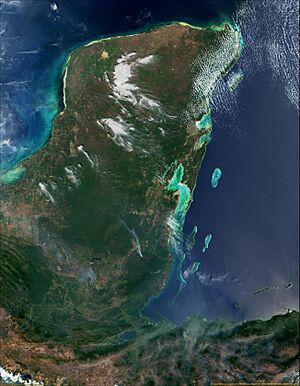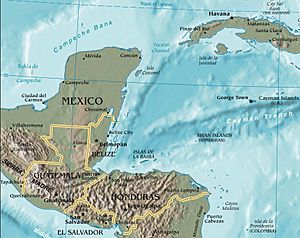Gulf of Honduras facts for kids
The Gulf of Honduras is a big part of the Caribbean Sea. It touches the coasts of three countries: Belize, Guatemala, and Honduras. This gulf stretches about 200 kilometers (124 miles) from north to south. It goes from a town called Dangriga in Belize all the way to La Ceiba in Honduras.
Contents
Amazing Coral Reefs
Inside the Gulf of Honduras, you'll find the Belize Barrier Reef. This reef is a southern part of the huge Mesoamerican Barrier Reef System. It's the second-largest coral reef system in the whole world! The Belize Barrier Reef has many small islands. These islands are called cays, and together they are known as the Pelican Cays.
A Home for Many Creatures
The Gulf of Honduras has a very special and diverse environment. It's a mix of coastal waters and open ocean. This creates many different types of habitats for plants and animals.
Different Habitats
You can find many cool places here, such as:
- Estuaries: Where rivers meet the sea.
- Barrier beaches: Long, narrow islands that protect the coast.
- Lagoons: Shallow bodies of water separated from the sea.
- Salt marshes: Grassy areas that are flooded by tides.
- Mangrove forests: Trees that grow in salty water along the coast.
- Seagrass beds: Underwater meadows of grass.
- Keys: Small, low islands.
- Barrier reefs: Large underwater structures made of coral.
Rivers and Their Impact
Many rivers flow into the Gulf of Honduras. There are 12 rivers in total, including the Moho, Sarstún, Río Dulce, Motagua, and Ulúa. These rivers bring a lot of water into the gulf. They also carry sediment (like mud and sand). When too much sediment enters the gulf, it can harm the delicate marine ecosystem (the plants and animals that live in the sea).
Fun Activities and History
The Gulf of Honduras is a popular spot for visitors.
Fishing and Tourism
Many American anglers (people who fish) come here to catch marlin. Marlin are large, fast fish known for their long, pointed snouts. Tourists also enjoy boat trips to the Pelican Cays. Two famous cays are Caye Caulker and Ambergris Caye. These places are great for exploring the beautiful waters and reefs.
Hurricane Hattie
In 1961, a very strong storm called Hurricane Hattie moved across the Gulf of Honduras. It caused a lot of damage, especially to buildings in Belize.
See also
 In Spanish: Golfo de Honduras para niños
In Spanish: Golfo de Honduras para niños



